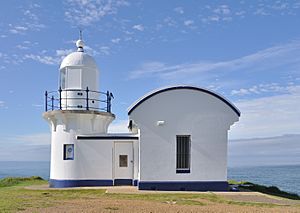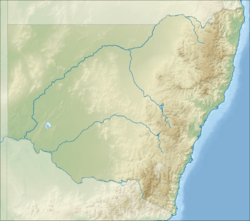Tacking Point Lighthouse facts for kids
 |
|
| Tacking Point Lighthouse, 2012 | |
|
|
|
| Location | Port Macquarie New South Wales Australia |
|---|---|
| Coordinates | 31°28′32″S 152°56′14″E / 31.4755°S 152.9372°E |
| Year first constructed | 1879 |
| Automated | 1919 |
| Construction | cement render bricks |
| Tower shape | cylindrical tower with balcony and lantern |
| Markings / pattern | white tower, lantern and attached storeroom, blue balcony rail |
| Height | 8 m (26 ft) |
| Focal height | 34 m (111 ft) |
| Intensity | 12,800 cd |
| Range | 16 nmi (30 km; 18 mi) |
| Characteristic | Fl (4) W 20s. |
| Admiralty number | K2788 |
| NGA number | 111-6024 |
| ARLHS number | AUS-158 |
The Tacking Point Lighthouse is a famous landmark in Australia. It is the thirteenth oldest lighthouse in the country. This means only twelve other lighthouses were built before it. It stands on a rocky cliff about 8 kilometres south of Port Macquarie.
The lighthouse was built in 1879 by Shepherd and Joseph William Mortley. Its design came from James Barnet, who was the main architect for the New South Wales government at the time. Today, the Australian Maritime Safety Authority looks after it. The lighthouse is also special because it is protected by the National Trust of Australia.
The name "Tacking Point" was given by explorer Matthew Flinders in 1802. He was sailing around Australia between 1802 and 1803. The closest lighthouses to Tacking Point are Smoky Cape Lighthouse to the north and Crowdy Head Light to the south.
Why Was Tacking Point Lighthouse Built?
In the mid-1800s, there were not many lighthouses in the Tacking Point area. This made it dangerous for ships, and more than 20 ships crashed there. One of the first shipwrecks happened in December 1823. A ship called the Black Jack was wrecked near Port Macquarie.
Because of these dangers, the Tacking Point Lighthouse was built in 1879. It had a special light that helped ships see their way. This lighthouse was one of five smaller lighthouses designed by James Barnet. Other lighthouses like Crowdy Head Light and Fingal Head Light were also built using his designs. Only Tacking Point and Crowdy Head lighthouses still have their original attached storerooms.
How Has the Lighthouse Changed Over Time?
The lighthouse was built using bricks covered with cement. It only needed to be 8 metres tall because it was built on a high cliff. This high spot helped its light shine far across the ocean.
In 1919, the lighthouse's light was updated. It changed from using oil to an automatic system that used acetylene gas. This meant that lighthouse keepers were no longer needed to live there. The last keeper left in 1920. Later, in 1974, the light was changed again to use electricity from the main power grid. You can still see the old foundations where the lighthouse keeper's house used to be.
Visiting Tacking Point Lighthouse
The area around Tacking Point Lighthouse is a popular spot for visitors. The lighthouse cliff marks the end of a long walking path. This path, called the Coastal Walk, is about 9 kilometres long. It stretches from Town Beach to Lighthouse Beach.
Many people also visit the lighthouse to watch for whales. During certain times of the year, whales swim close to the coast. The nearby Lighthouse Beach is also a great place for surfing. There is even a surf life-saving club there to keep swimmers safe.




